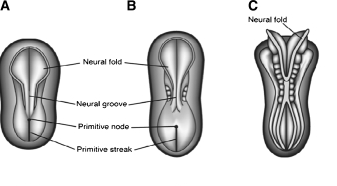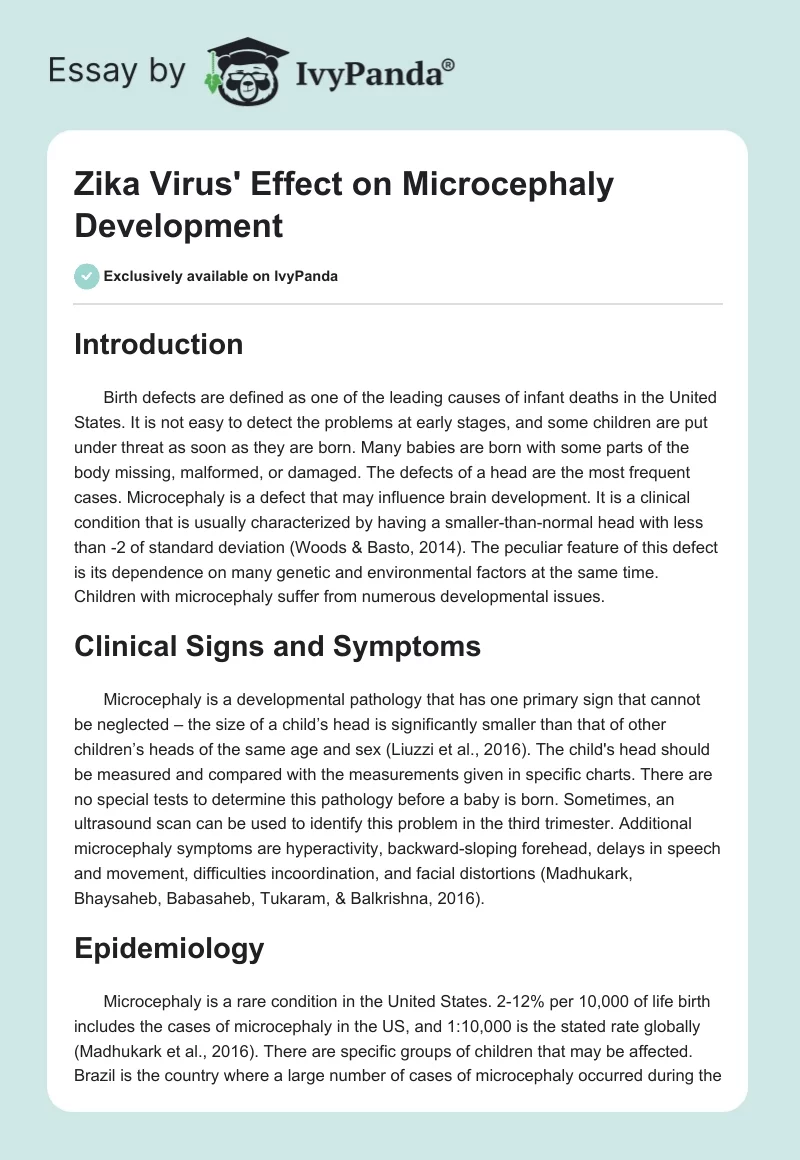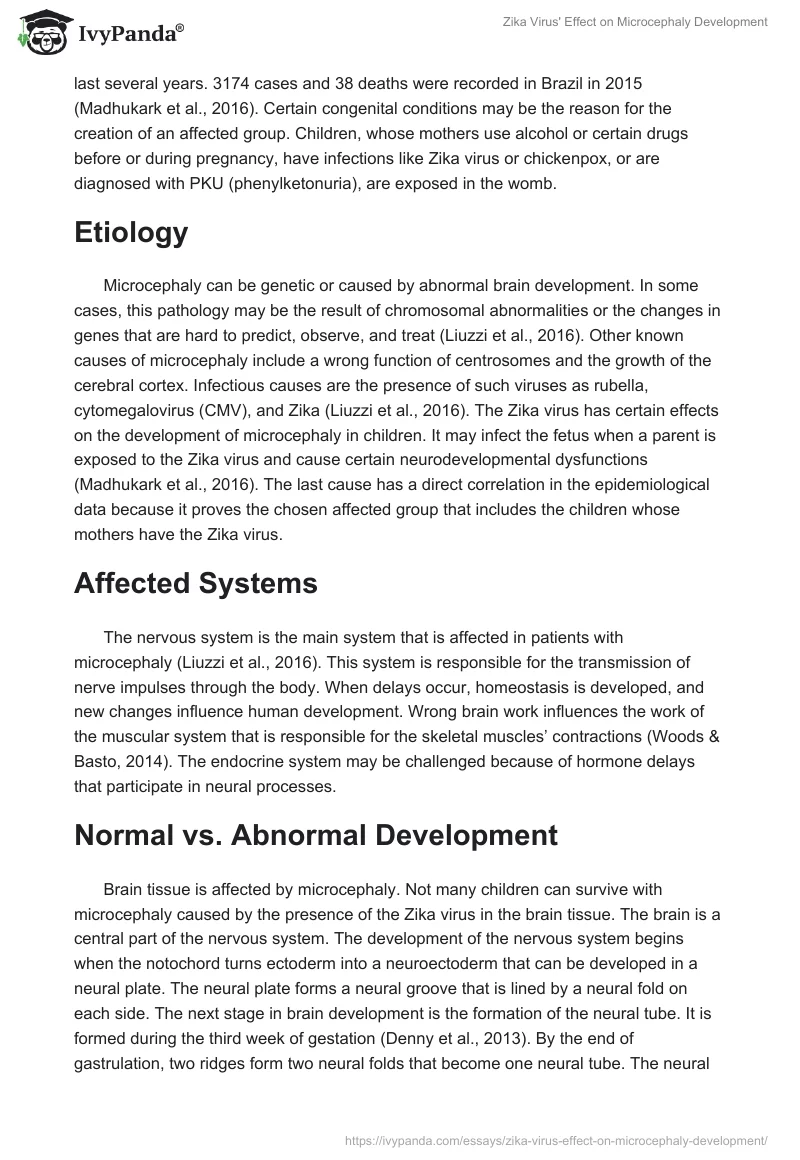Introduction
Birth defects are defined as one of the leading causes of infant deaths in the United States. It is not easy to detect the problems at early stages, and some children are put under threat as soon as they are born. Many babies are born with some parts of the body missing, malformed, or damaged. The defects of a head are the most frequent cases. Microcephaly is a defect that may influence brain development. It is a clinical condition that is usually characterized by having a smaller-than-normal head with less than -2 of standard deviation (Woods & Basto, 2014). The peculiar feature of this defect is its dependence on many genetic and environmental factors at the same time. Children with microcephaly suffer from numerous developmental issues.
Clinical Signs and Symptoms
Microcephaly is a developmental pathology that has one primary sign that cannot be neglected – the size of a child’s head is significantly smaller than that of other children’s heads of the same age and sex (Liuzzi et al., 2016). The child’s head should be measured and compared with the measurements given in specific charts. There are no special tests to determine this pathology before a baby is born. Sometimes, an ultrasound scan can be used to identify this problem in the third trimester. Additional microcephaly symptoms are hyperactivity, backward-sloping forehead, delays in speech and movement, difficulties incoordination, and facial distortions (Madhukark, Bhaysaheb, Babasaheb, Tukaram, & Balkrishna, 2016).
Epidemiology
Microcephaly is a rare condition in the United States. 2-12% per 10,000 of life birth includes the cases of microcephaly in the US, and 1:10,000 is the stated rate globally (Madhukark et al., 2016). There are specific groups of children that may be affected. Brazil is the country where a large number of cases of microcephaly occurred during the last several years. 3174 cases and 38 deaths were recorded in Brazil in 2015 (Madhukark et al., 2016). Certain congenital conditions may be the reason for the creation of an affected group. Children, whose mothers use alcohol or certain drugs before or during pregnancy, have infections like Zika virus or chickenpox, or are diagnosed with PKU (phenylketonuria), are exposed in the womb.
Etiology
Microcephaly can be genetic or caused by abnormal brain development. In some cases, this pathology may be the result of chromosomal abnormalities or the changes in genes that are hard to predict, observe, and treat (Liuzzi et al., 2016). Other known causes of microcephaly include a wrong function of centrosomes and the growth of the cerebral cortex. Infectious causes are the presence of such viruses as rubella, cytomegalovirus (CMV), and Zika (Liuzzi et al., 2016). The Zika virus has certain effects on the development of microcephaly in children. It may infect the fetus when a parent is exposed to the Zika virus and cause certain neurodevelopmental dysfunctions (Madhukark et al., 2016). The last cause has a direct correlation in the epidemiological data because it proves the chosen affected group that includes the children whose mothers have the Zika virus.
Affected Systems
The nervous system is the main system that is affected in patients with microcephaly (Liuzzi et al., 2016). This system is responsible for the transmission of nerve impulses through the body. When delays occur, homeostasis is developed, and new changes influence human development. Wrong brain work influences the work of the muscular system that is responsible for the skeletal muscles’ contractions (Woods & Basto, 2014). The endocrine system may be challenged because of hormone delays that participate in neural processes.
Normal vs. Abnormal Development
Brain tissue is affected by microcephaly. Not many children can survive with microcephaly caused by the presence of the Zika virus in the brain tissue. The brain is a central part of the nervous system. The development of the nervous system begins when the notochord turns ectoderm into a neuroectoderm that can be developed in a neural plate. The neural plate forms a neural groove that is lined by a neural fold on each side. The next stage in brain development is the formation of the neural tube. It is formed during the third week of gestation (Denny et al., 2013). By the end of gastrulation, two ridges form two neural folds that become one neural tube. The neural progenitor cells can be found between the ridges. Fusion o the neural folds is initiated at several places of the rostral-caudal axis (Stiles & Jernigan, 2010). After fusion, two continuous epithelial layers are formed. One is outer surface ectoderm, and another is a neural tube. Before the end of the fourth week of gestation, the caudal neuropore closes, and the neural tube is formed (Stiles & Jernigan, 2010). At the beginning of the neurulation process, the embryo is 3-5 mm long. At the end of the neural tube’s formation, the size of the embryo is 27-31 mm.

In Figure 1, there are several pictures that can be used as the fate-map of normal development of the neural tube in the embryo. A – the formation of the neural ridges, B – the beginning of the neural tube formation, C – the end of the neural tube formation. Microcephaly is the condition caused by unpredictable and uncontrollable neural stem cell proliferation during the embryonic development that may result in the death of neurons (Denny et al., 2013). The Zika virus, as the main contributor of microcephaly in fetuses, may infect an organism and kill the primary stem cells that have to be properly developed in the brain. The loss of any neuron leads other changes in head’s size and the development of human brain functions.
Treatment
The main threat of microcephaly is that no definite treatment can be offered to children. It is impossible to reverse complications or enlarge the size of child’s head. No direct treatment, but only alternative ideas should be discussed. The goal of any treatment is to manage child’s condition and support them and their families by any possible means, including speech and physical developmental therapies and occupational therapies which strengthen child’s abilities. Some medications and relaxing exercises can be offered to deal with hyperactivity if any.
Personal Interest
The fact that people cannot find out treatment for such pathology, it is interesting and challenging to observe the latest news and achievements on the chosen topic. The consideration of biological research and conferences can help to check on the latest changes and realize if microcephaly can be treated, and children can be saved. It is not fair that children should suffer from such birth defect as microcephaly, and it is necessary to do something to find the solution.
References
Denny, K.J., Jeanes, A., Fathe, K., Finnell, R.H., Taylor, S.M., & Woodruff, T.M. (2013). Neural tube defects, folate, and immune modulation. Birth Defect Research Part A: Clinical and Molecular Teratology, 97(9), 602-609.
Liuzzi, G., Puro, V., Vairo, F., Nicastri, E., Capobianchi, M.R., di Caro, A., … Ippolito, G. (2016). Zika virus and microcephaly: Is the correlation, causal or coincidental? New Microbiologica, 39(2), 83-85.
Madhukark, G.V., Bhaysaheb, D.K., Babasaheb, K.K., Tukaram, D.R., & Balkrishna, S.S. (2016). Zika virus infection: An overview. World Journal of Pharmacy and Pharmaceutical Science, 5(4), 2191-2204.
Stiles, J., & Jernigan, T.L. (2010). The basics of brain development. Neuropsychology Review, 20(4), 327-348.
Woods, C.G., & Basto, R. (2014). Microcephaly. Current Biology, 24(23), 1109-1111.


